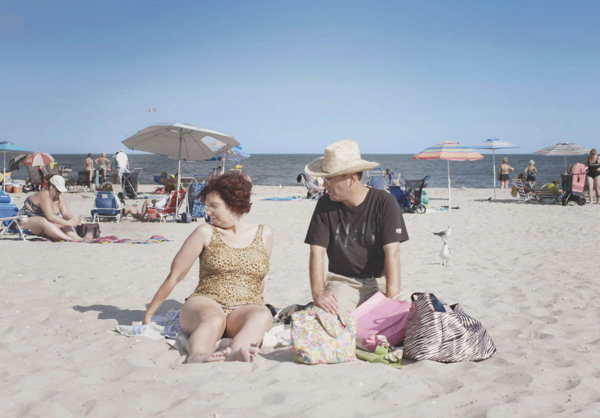Movie review by Greg Carlson
The U.S. documentary grand jury prize winner at the 2017 Sundance Film Festival, Antonio Santini and Dan Sickles’ “Dina” is an empathetic portrait of love and resilience. Following the ups and downs of the wedding preparations undertaken by title subject Dina Buno and her husband-to-be Scott Levin in greater Philadelphia, the film cultivates and carefully manages its precise point of view. Buno and Levin live with a number of recognizable neurodevelopmental disorders, and the latter identifies as a person with Asperger syndrome, but the filmmakers resolutely avoid the clichés of films focused on people with special needs.
Framing close to the au courant Academy ratio, Santini and Sickles employ long, static takes often composed at a physical remove from the primary action. The disarming technique contrasts sharply with the popularity of nonfiction stories shot handheld (fueled by the “necessaity” to capture/cover events that might otherwise be missed). The filmmakers’ careful and deliberate arrangements demonstrate an unhurried patience that pays dividends when surprising moments and revelations unfold before our eyes. The fly-on-the-wall sensation is additionally complemented by the bold absence of voiceover narration and talking head interviews.
The trust extended by Dina to the directors infuses every scene of the movie. As reported by Kate Erbland, Sickles is a lifelong friend of Buno, who was mentored by Sickles’ father in his capacity as a high school teacher and a co-founder of the community service organization that was originally going to be the broader subject of Sickles and Santini’s feature. Dina’s engagement to Levin sharpened the focus, and the result, while still including other members of the Abington Aktion Club, benefits from the microcosmic examination of the changes wrought by a new marriage.
The moviemakers recognize that, along with Dina’s personal history – her first husband died and she was assaulted by a boyfriend – the ongoing physical intimacy issues between Dina and Scott offer both the narrative’s key conflict and an opportunity to connect with viewers not on the autism spectrum. The film resists the simplistic and condescending tendency to “universalize” Dina and Scott in their pre-nuptial negotiations by entirely bypassing any kind of hand-wringing or second-guessing regarding the sexual rights of its principal pair.
Instead, Sickles and Santini are confident enough to showcase plenty of awkward humor that might read as insensitive or exploitative in less skillful and/or educated hands. Scott’s struggle to meet Dina’s outspoken carnal needs builds through a series of exchanges that routinely evoke the wincing self-recognition of nearly any romantic partnership. The earthy, ebulilient Dina cuts loose at her bachelorette party with a stripper while Scott prefers a more sedate trip to a bowling alley. Later, a dip in the giant, martini glass-shaped, honeymoon suite tub filled with bubbles is a sight to behold.
In what is probably the movie’s most discussed moment, Santini and Sickles share the audio recording of the 911 call from the night that Dina was violently attacked. The juxtaposition of this alarmingly raw information (Dina has been stabbed but remains incredibly composed in her converstation with the operator) with a portrait of hope and possibility promised by a new life is a representative example of the position staked out and asserted by Dina and by the directors.
